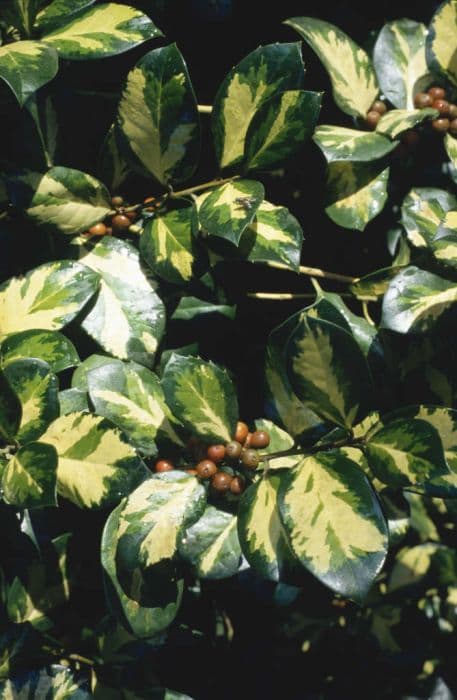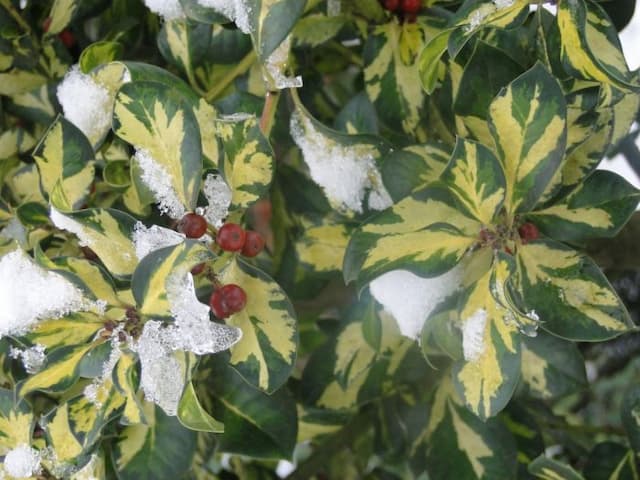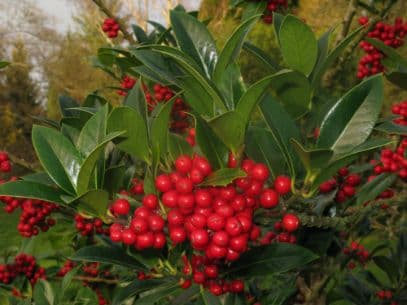English Holly Ilex aquifolium 'Amber' (f)

ABOUT
Ilex aquifolium 'Amber' (f), commonly known as the European Holly, is notable for its rich green foliage and distinctive berries. The plant's leaves have a classic shape with spiny margins that recall the festive images commonly associated with holly. Typically glossy, the leaves exhibit a vibrant green color that provides a striking contrast to the amber-colored berries, for which this cultivar is named. The berries have a translucent quality that seems to glow when they catch the light. These ornamental fruits cluster along the branches and stand out against the foliage, adding visual interest. The plant maintains its showy appearance across the seasons, making it a favored choice for gardens where year-round appeal is desired.
About this plant
 Names
NamesFamily
Aquifoliaceae.
Synonyms
English Holly, Common Holly, European Holly.
Common names
Ilex aquifolium 'Amber' (f)
 Toxicity
ToxicityTo humans
European holly, including the variety 'Amber', contains toxic substances primarily in its berries and to a lesser extent in the leaves. Ingestion of these parts can cause symptoms such as nausea, vomiting, diarrhea, and abdominal pain. The severity of symptoms depends on the amount ingested, with serious cases potentially leading to drowsiness, seizures, or even death, although such extreme reactions are rare.
To pets
European holly can be toxic to pets if ingested. The berries and leaves contain theobromine and saponins, which can cause symptoms like vomiting, diarrhea, and excessive drooling in animals. In severe cases, ingestion can lead to lethargy, dehydration, and potentially be fatal if not treated promptly. It is advisable to keep pets away from this plant to avoid accidental ingestion.
 Characteristics
CharacteristicsLife cycle
Perennials
Foliage type
Evergreen
Color of leaves
Green
Flower color
White
Height
6-10 feet (1.8-3 meters)
Spread
4-8 feet (1.2-2.4 meters)
Plant type
Shrub
Hardiness zones
5-9
Native area
Europe
Benefits
 General Benefits
General Benefits- Ornamental Value: Ilex aquifolium 'Amber' offers decorative appeal with its glossy green leaves and distinctive red berries.
- Wildlife Attraction: The berries provide a valuable food source for birds and other wildlife during the winter months.
- Hedging and Screening: Its dense growth habit makes it an excellent choice for creating hedges or natural screens for privacy and wind protection.
- Drought Tolerance: Once established, this plant has good drought tolerance, making it suitable for drier conditions or water-wise gardens.
- Soil Adaptability: It can adapt to a wide range of soil conditions, though it prefers well-drained, moderately fertile soils.
- Low Maintenance: Requires minimal pruning and care, making it a good choice for gardeners seeking low-maintenance landscaping.
- Seasonal Interest: Provides year-round interest due to its evergreen nature and seasonal berry production.
- Tolerates Shade: It can grow in full sun to partial shade, providing flexibility in landscaping designs.
- Hardiness: Exhibits good resistance to cold and can survive in harsh winter climates, making it suitable for many regions.
- Architectural Use: The structured shape and texture of the leaves can add architectural interest to gardens and landscapes.
 Medical Properties
Medical PropertiesThis plant is not used for medical purposes.
 Air-purifying Qualities
Air-purifying QualitiesThis plant is not specifically known for air purifying qualities.
 Other Uses
Other Uses- The berries of the Holly can be used to make natural dyes, offering colors ranging from various shades of red to purple on different types of materials.
- Wood from the Holly is highly valued in carpentry for inlays and detailed furniture work due to its fine, white grain and workability.
- Holly leaves can serve as a natural deterrent in gardens for keeping away deer and other animals who might be deterred by the spiny leaves.
- The plant can be used for topiary and shaped into a variety of forms for decorative purposes in gardens and landscapes.
- Dried Holly branches and berries are often used in floral arrangements and wreaths, especially during the winter holiday season.
- Using Holly for hedging can create secure boundaries, as the dense growth and prickly leaves form a 'living fence' that is difficult to penetrate.
- Holly wood is used for crafting musical instruments like flutes and bagpipes, for its consistency and fine tone quality.
- The spiky texture of the leaves can be used for crafting natural Christmas decorations, adding an authentic touch to holiday decor.
- In small quantities, the leaves of Holly have traditionally been used to feed livestock during winter when other forage is not available.
- When planted densely, Holly can serve as a windbreak, protecting more vulnerable plants and reducing soil erosion in the landscape.
Interesting Facts
 Feng Shui
Feng ShuiThe common name for Ilex aquifolium 'Amber' is Holly. In Feng Shui, Holly can be used to promote positive energy and create a protective barrier against negative influences. It might be placed outside the front door or in the garden to ward off negative Chi.
 Zodiac Sign Compitability
Zodiac Sign CompitabilityThe Holly is not used in astrology practice.
 Plant Symbolism
Plant Symbolism- Protection: Ilex aquifolium, commonly known as Holly, is often considered a symbol of protection. Its spiky leaves were thought to ward off evil spirits and negative energies.
- Immortality: Holly is an evergreen plant, retaining its green foliage throughout the year, which symbolizes eternal life and immortality.
- Fertility: With its vibrant red berries, Holly represents fertility and life, often associated with the vitality of nature.
- Hope: As an evergreen that survives even in the harsh winter, Holly is a symbol of hope and the promise of renewal.
- Peace: Holly's association with Christmas has made it a symbol of peace and goodwill, aligning with the themes of the holiday season.
 Water
WaterThe common name for Ilex aquifolium 'Amber' (f) is English Holly 'Amber.' When watering your English Holly 'Amber,' ensure the soil is consistently moist but never waterlogged. Water the plant when the top inch of soil feels dry, which typically amounts to approximately 1 gallon of water every week during the growing season. In the winter, you can reduce the frequency to half a gallon every two weeks, assuming it is not freezing outside. Always check the soil moisture level before watering to avoid overwatering, which can lead to root rot.
 Light
LightEnglish Holly 'Amber' prefers bright, indirect light but can also tolerate partial shade. The best spot for this holly would be where it receives morning sunlight and is protected from the intense afternoon sun. However, this plant can adapt to low-light conditions but may produce fewer berries as a result.
 Temperature
TemperatureThe English Holly 'Amber' can tolerate a range of temperatures but thrives in conditions between 50°F and 70°F. It can withstand low temperatures down to about 20°F without severe damage. Ensure that the plant is not subjected to temperatures exceeding 80°F for extended periods, as this may cause stress.
 Pruning
PruningPrune English Holly 'Amber' to maintain its shape and encourage bushier growth. The best time for pruning is in the late winter or early spring before new growth begins. Pruning can be done annually, focusing on removing dead or damaged branches and shaping the plant as desired.
 Cleaning
CleaningAs needed
 Soil
SoilEnglish Holly 'Amber' prefers a well-draining, humus-rich soil mix with a slight acidic to neutral pH of about 5.5 to 7.5. A mixture of garden soil, peat moss, and perlite can provide the desired structure and drainage.
 Repotting
RepottingEnglish Holly 'Amber' should be repotted every 2 to 3 years, best done in the late winter or early spring before new growth begins.
 Humidity & Misting
Humidity & MistingEnglish Holly 'Amber' tolerates a wide range of humidity levels but thrives best in moderate to high humidity environments, avoiding excessively dry conditions.
 Suitable locations
Suitable locationsIndoor
Place English Holly 'Amber' in bright, indirect light indoors.
Outdoor
Plant English Holly 'Amber' in partial shade to full sun outdoors.
Hardiness zone
5-9 USDA
 Life cycle
Life cycleIlex aquifolium 'Amber', commonly known as 'Amber' English Holly, begins its life as a seed, which, when conditions are favorable, germinates and sprouts into a seedling. The seedling stage involves the establishment of a root system and the emergence of the initial leaves. As the plant matures, it enters the vegetative stage, growing larger and developing the characteristic spiny, glossy green leaves and woody stems. Once the plant reaches sexual maturity, which can take several years, it enters the reproductive stage, producing small white flowers that are dioecious, meaning male and female flowers are on separate plants; 'Amber' being a female clone, requires a nearby male holly to pollinate the flowers. Successful pollination leads to the production of the plant's distinctive red berries, which not only serve as a food source for birds but also assist in the dispersal of seeds for new plant growth. Finally, the holly can live for many years, reaching stages of senescence before eventually dying, during which growth slows and the plant may become more susceptible to environmental stress and disease.
 Propogation
PropogationPropogation time
Late winter to early spring
Propogation: Ilex aquifolium 'Amber', commonly known as Amber English Holly, is typically propagated through semi-hardwood cuttings. The ideal time to take these cuttings is in late summer to early fall when the current year's growth has begun to mature but is not fully hardened. The process involves selecting a healthy branch and cutting sections that are 4 to 6 inches (10 to 15 centimeters) in length. Each cutting should have at least two to three sets of leaves. The lower set of leaves is removed, and the cut end is dipped in rooting hormone to encourage root development. The prepared cuttings are then planted in a mixture of peat and perlite or sand, ensuring that the leaves do not touch the soil to prevent rot. The cuttings need to be kept in high humidity and consistent moisture until roots are established, which can take several weeks.









